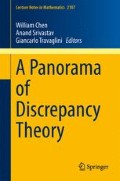Abstract
This chapter describes some recent results in combinatorial discrepancy theory motivated by designing efficient polynomial time algorithms for finding low discrepancy colorings. Until recently, the best known results for several combinatorial discrepancy problems were based on counting arguments, most notably the entropy method, and were widely believed to be non-algorithmic. We describe some algorithms based on semidefinite programming that can achieve many of these bounds. Interestingly, the new connections between semidefinite optimization and discrepancy have lead to several new structural results in discrepancy itself, such as tightness of the so-called determinant lower bound and improved bounds on the discrepancy of union of set systems. We will also see a surprising new algorithmic proof of Spencer’s celebrated six standard deviations result due to Lovett and Meka, that does not rely on any semidefinite programming or counting argument.
Access this chapter
Tax calculation will be finalised at checkout
Purchases are for personal use only
Notes
- 1.
Interestingly, an improved \(O(\sqrt{t\log n})\) bound is also known [2] using a different method based on convex geometry.
- 2.
- 3.
Note that one cannot set \(\lambda = o(\sqrt{n})\) in our setting, there are set systems on m = O(n) sets (e.g. the Hadamard set system, that we will see in Sect. 6.6) with vector discrepancy \(\varOmega (\sqrt{n})\).
References
N. Alon, J.H. Spencer, The probabilistic method. With an appendix on the life and work of Paul Erdős. 2nd ed. (Wiley-Interscience Series in Discrete Mathematics and Optimization. Wiley, Chichester, xvi, 301 p., New York, 2000)
W. Banaszczyk, Balancing vectors and Gaussian measures of n-dimensional convex bodies. Random Struct. Algorithm 12(4), 351–360 (1998). doi:10.1002/(SICI)1098-2418(199807)12:4<351::AID-RSA3>3.0.CO;2-S
N. Bansal, Constructive Algorithms for Discrepancy Minimization, in Foundations of Computer Science (FOCS), 2010, pp. 3–10
N. Bansal, J.H. Spencer, Deterministic discrepancy minimization., in 19th annual European symposium, Saarbrücken, Germany, September 5–9, 2011. Proceedings, Algorithms – ESA 2011, ed. by C. Demetrescu, et al. Lecture Notes in Computer Science, vol. 6942 (Springer, Berlin, 2011), pp. 408–420. doi:10.1007/978-3-642-23719-5_35
J. Beck, Roth’s estimate of the discrepancy of integer sequences is nearly sharp. Combinatorica 1, 319–325 (1981). doi:10.1007/BF02579452
J. Beck, T. Fiala, Integer-making theorems. Discrete Appl. Math. 3, 1–8 (1981)
J. Bourgain, L. Tzafriri, Invertibility of “large” submatrices with applications to the geometry of Banach spaces and harmonic analysis. Isr. J. Math. 57(2), 137–224 (1987). doi:10.1007/BF02772174
K. Chandrasekaran, S. Vempala, A discrepancy based approach to integer programming. CoRR abs/1111.4649 (2011)
M. Charikar, A. Newman, A. Nikolov, Tight Hardness Results for Minimizing Discrepancy, in Proceedings of the Twenty-Second Annual ACM-SIAM Symposium on Discrete Algorithms, SODA 2011, San Francisco, California, USA, January 23–25, 2011, ed. by D. Randall, 2011, pp. 1607–1614
B. Chazelle, The discrepancy method. Randomness and complexity. (Cambridge University Press, Cambridge, 2000), p. 463
T.M. Cover, J.A. Thomas, Elements of information theory. 2nd ed. (Wiley-Interscience. Wiley, Hoboken, NJ, 2006), p. 748. doi:10.1002/047174882X
B. Doerr, Linear and hereditary discrepancy. Combinator. Probab. Comput. 9(4), 349–354 (2000). doi:10.1017/S0963548300004272
M. Drmota, R.F. Tichy, Sequences, discrepancies and applications. Lecture Notes in Mathematics, vol. 1651 (Springer, Berlin, 1997), p. 503. doi:10.1007/BFb0093404
F. Eisenbrand, D. Pálvölgyi, T. Rothvoß, Bin Packing via Discrepancy of Permutations, in Proceedings of the Twenty-Second Annual ACM-SIAM Symposium on Discrete Algorithms, SODA 2011, San Francisco, California, USA, January 23–25, 2011, ed. by D. Randall, 2011, pp. 476–481
V. Guruswami, Inapproximability results for set splitting and satisfiability problems with no mixed clauses. Algorithmica 38(3), 451–469 (2004). doi:10.1007/s00453-003-1072-z
J.H. Kim, J. Matoušek, V.H. Vu, Discrepancy after adding a single set. Combinatorica 25(4), 499–501 (2005). doi:10.1007/s00493-005-0030-x
D.J. Kleitman, On a combinatorial conjecture of Erdős. J. Combin. Theory 1, 209–214 (1966). doi:10.1016/S0021-9800(66)80027-3
L. Lovász, J.H. Spencer, K. Vesztergombi, Discrepancy of set-systems and matrices. Eur. J. Combinator. 7, 151–160 (1986)
S. Lovett, R. Meka, Constructive Discrepancy Minimization by Walking on the Edges, in Foundation of Computer Science (FOCS), 2012, pp. 61–67
J. Matoušek, Geometric discrepancy. An illustrated guide. Revised paperback reprint of the 1999 original. Algorithms and Combinatorics, vol. 18 (Springer, Dordrecht, 2010), p. 296. doi:10.1007/978-3-642-03942-3
J. Matoušek, The determinant bound for discrepancy is almost tight. Proc. Am. Math. Soc. 141(2), 451–460 (2013). doi:10.1090/S0002-9939-2012-11334-6
A. Nikolov, K. Talwar, L. Zhang, The Geometry of Differential Privacy: the Approximate and Sparse Cases., in Symposium on Theory of Computing (STOC), 2013. to appear.
D. Pálvölgyi, Indecomposable coverings with concave polygons. Discrete Comput. Geom. 44(3), 577–588 (2010). doi:10.1007/s00454-009-9194-y
T. Rothvoß, The entropy rounding method in approximation algorithms, in Symposium on Discrete Algorithms (SODA), 2012, pp. 356–372
T. Rothvoß, Approximating bin packing within o(log opt * log log opt) bins. CoRR abs/1301.4010 (2013)
M. Sipser, Introduction to the theory of computation. (PWS Publishing, Boston, MA, 1997), p. 396
J.H. Spencer, Six standard deviations suffice. Trans. Am. Math. Soc. 289(2), 679–706 (1985). doi:10.2307/2000258
A. Srinivasan, Improving the Discrepancy Bound for Sparse Matrices: Better Approximations for Sparse Lattice Approximation Problems, in Symposium on Discrete Algorithms (SODA), 1997, pp. 692–701
L. Vandenberghe, S. Boyd, Semidefinite programming. SIAM Rev. 38(1), 49–95 (1996). doi:10.1137/1038003
R. Vershynin, John’s decompositions: Selecting a large part. Isr. J. Math. 122, 253–277 (2001). doi:10.1007/BF02809903
Author information
Authors and Affiliations
Corresponding author
Editor information
Editors and Affiliations
Rights and permissions
Copyright information
© 2014 Springer International Publishing Switzerland
About this chapter
Cite this chapter
Bansal, N. (2014). Algorithmic Aspects of Combinatorial Discrepancy. In: Chen, W., Srivastav, A., Travaglini, G. (eds) A Panorama of Discrepancy Theory. Lecture Notes in Mathematics, vol 2107. Springer, Cham. https://doi.org/10.1007/978-3-319-04696-9_6
Download citation
DOI: https://doi.org/10.1007/978-3-319-04696-9_6
Published:
Publisher Name: Springer, Cham
Print ISBN: 978-3-319-04695-2
Online ISBN: 978-3-319-04696-9
eBook Packages: Mathematics and StatisticsMathematics and Statistics (R0)

